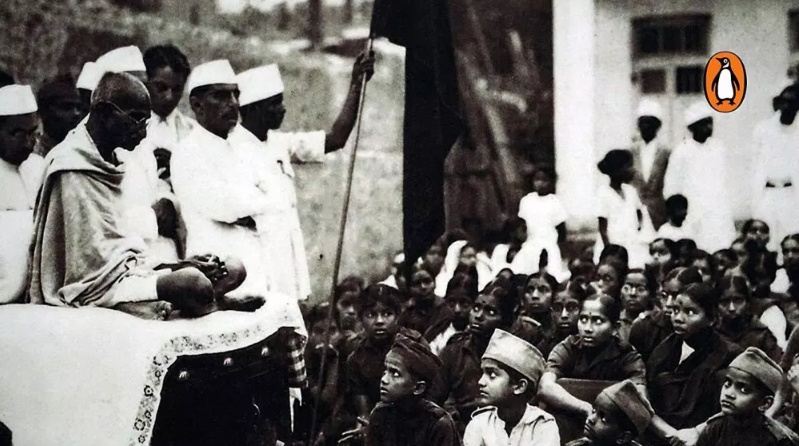
It was Gandhi, first in South Africa and then in India, who both evolved a technique that he called ‘satyagraha’ that he characterised in terms of its ‘non-violence’. In this, ‘non-violence’ was forged as both a new word in the English language, and as a new political concept.
The Non-violent Struggle for Freedom by David Hardiman brings out in graphic detail exactly what this entailed, and the formidable difficulties that the pioneers of such resistance encountered in the years 1905-19.
Here is an excerpt from the book:
The idea of nonviolence as a form of political strategy was theorised by Gandhi in India during the second decade of the twentieth century. The Oxford English Dictionary states that the first recorded usage of the word – in its hyphenated form – was in the nineteenth century as a medical term describing either a certain type of surgical procedure (Britain) or the failure of the body to resist the violence that is inflicted on it by disease (USA). Only in 1914 did it appear in a political context when a Wisconsin newspaper contrasted ‘rumpus and riot’ with ‘the tenets of moderation, orderly thinking and non-violence’. The next usage recorded in the dictionary was by Gandhi, who stated in 1920: ‘I believe that non-violence is infinitely superior to violence, forgiveness is more manly than punishment.’ Despite the preceding appearances of the word in Britain and the USA, the dictionary gives its etymology as a translation of the Sanskrit word ahimsa, which is a combination of a- (non-) and himsa (violence). This indeed was how Gandhi was to project the idea – namely that nonviolence was a major philosophical principle that was rooted in ancient India. If, however, we look at the nineteenth-century Sanskrit- English dictionary by Monier-Williams, we find that the term – spelt here as ahinsa – is translated as ‘not injuring anything, harmlessness (one of the cardinal virtues of most Hindu sects, but particularly of the Buddhists and Jains; also personified as the wife of Dharma)…security, safeness’. Ahinsa-nirata is defined as ‘harmlessness or gentleness’, ahinsana as ‘not hurting’, and ahinsra as ‘innocuous, harmless behaviour’. The term thus suggested passivity, rather than a principled resistance to wrong-doing that avoids the use of violence – as Gandhi understood it.
***********************************
In the past, ahimsa was hardly deemed to have any applicability to popular protest, or be some sort of political technique. This only became possible in the epistemic space that we associate with modernity, with its emphasis on the need of states to enjoy popular legitimacy and with acts of mass civil protests becoming one major way in which popular feeling may be expressed. In emphasising the need for peaceful means, dissent could be expressed without the need for that violence that could threaten both civil tolerance and even civil society itself. Although such a principle was conceived initially conceived in terms of the secular method of ‘passive resistance’, with peaceable methods being deployed tactically rather than as a matter of principle, it was Gandhi who first tried to make ahimsa-cum-nonviolence into an imperative principle for all forms of civil protest. In doing so, he claimed a compelling power to a moral stance that was, as he understood it, invested with divine power – that of ‘truth force’. In this, God/Truth was accorded agency. Secular notions of ‘passive resistance’, ‘civil resistance’, ‘people power’ and the like never made such a daring claim.
Gandhi only began to talk about ahimsa as an informing principle of his method of resistance after his return to India from South Africa in 1915. Gandhi only began to talk about ahimsa as an informing principle of his method of resistance after his return to India from South Africa in 1915. Although Gandhi had already forged his method of satyagraha, he had never previously described it as a form of either ‘ahimsa’ or ‘nonviolence’. There has been some confusion on this matter, as the Collected Works of Mahatma Gandhi gives the impression that he deployed the concept when he launched his first campaign of passive resistance in 1906. In this source, Gandhi had allegedly asserted: ‘This is for us the time for deeds, not words. We have to act boldly; and in doing so, we have to be humble and non-violent.’ If we examine the original version in Gujarati, we find that he is quoted as saying ‘…narmash vaparvani che’ which literally means ‘make use of softness’. In fact, the root of ‘narmash’ is the noun ‘naram’, which means soft and smooth, gentle, tender, humble, soft, weak, effeminate. In other words, it suggests passivity, a connotation that Gandhi was soon to distance himself from.
Although non-violence is associated above all with the towering figure of M.K. Gandhi, David Hardiman shows – in his book, The Non Violent Struggle for Freedom – that civil forms of resistance were already being practiced by nationalists in British-ruled India under the rubric of ‘passive resistance’.









